In response to Bitcoin network scaling issues, the Lightning Network was one of the proposed solutions along with SegWit and increasing block size, the solution that ultimately became Bitcoin Cash. In fact, despite SegWit being adopted much quicker, the Lightning Network was proposed first. Like Bitcoin nodes, payment channels act as gateways to the Lightning Network but unlike Bitcoin, there are no miners. Instead, the Lightning Network is kept secure through its own smart contracts.
A web of payment channels
The core element of the Lightning Network is a payment channel. To participate in the network, you need special software - a Lightning Network client - that takes care of facilitating users’ payments through creating payment channels.
For example, using a payment channel, two users in the Bitcoin network are able to send transactions and consequently update the balance of the channel up to a limit that has been locked in the payment channel beforehand.
After an initial transaction for funding has been made to open a channel in the Lightning Network, the users themselves can make any number of transactions with one another without these transactions being stored in the blockchain, consequently relieving the burden on the blockchain and scaling up the network in the process.
How does the Lightning Network support Bitcoin?
After each payment, the current balance is recorded in a “commitment transaction” that has to be signed off by both parties. This idea is based on a concept similar to that of a current account in classic commercial law, where periodic billing has been agreed upon as part of a permanent business relationship and mutual services are continually booked.
After each payment, the current balance is recorded in a “commitment transaction” that has to be signed off by both parties.
However, in the case of a payment channel in the Lightning Network, claims are only settled once one of the participants closes the payment channel by publishing a settlement transaction. It is this action that records the final balance between both parties in the final commitment transaction directly on the blockchain. Unlike in the case of a current account, the two parties involved do not need to trust each other. Still, transactions in a payment channel only take place upon mutual agreement of both parties. The throughput of the payment channel is only limited by latency and the throughput of the TCP socket used.
It is worth mentioning here that users should still pay attention to blockchain activity in regards to settling these transactions. It is possible that a user would try to settle an account with an out-of-date settlement transaction. The other party should, in this case, publish the later transaction settlement in order to dispute it.
Channels are the paths from one cryptocurrency wallet to another. In order to use the Lightning Network, users have to get a cryptocurrency wallet that supports the Lightning Network.
